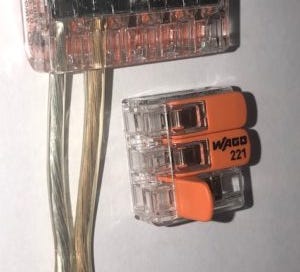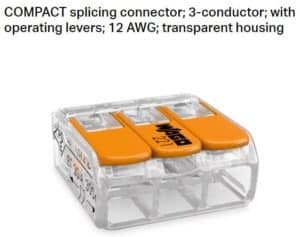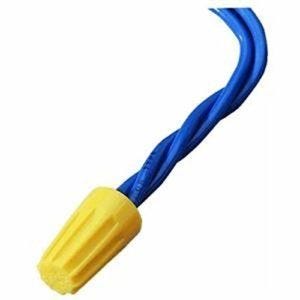Dear Readers,
This could be the greatest innovation in wire splicing technology since the invention of the wire nut. And it looks like the RV industry is adopting it quickly. It’s the WAGO 221 lever action splicing block.
Why am I excited about this? Well, traditional wire nuts are notorious for being difficult to install properly, especially once you’re trying to splice more than two wires together. Plus, it’s difficult to get a visual indication of proper termination. Yes, wire nuts are a big failure point in RVs (as well as home wiring).
A few years ago when I was teaching an RV technician class one of the senior technicians gave me a WAGO 221 splicing block to play with. So I threw it in my glove compartment and forgot about it. However, shortly after that I was doing a consult on an RV that had developed a hot-skin voltage condition, and the repair shop foreman showed me a big box of WAGO connectors in all sizes, and said that Forest River was now using them on their new RV builds, and that his technicians loved them. So I took a few home to try.
Well, I do believe this is a great advance in reducing electrical failures due to overheating and intermittent connections due to improperly installed and maintained wire nuts. That’s because..
1) the WAGO connector is clear, allowing you to clearly see when the conductors have been properly stripped and seated;
2) they clamp down with a spring-loaded lever you can’t over-tighten and which can’t loosen up from vibration
3) the more you pull on the wire, the tighter it grips the conductor. Very cool.
It appears that Progressive Dynamics (the company that manufactures the circuit breaker panel in your RV) is utilizing the WAGO connector instead of screw termination in some of their products. Now, that’s getting interesting!
I’ve already contacted WAGO for technical literature and some samples to experiment with, but these lever-action splice blocks could go a long way to reducing wire nut splice failures in your RV. And yes, you can indeed get them on Amazon HERE.
So are wire nuts dead? Certainly not. But unless they’re installed properly to begin with they can be a big source of failure and frustration in RV electrical systems. And if improperly installed they can become a source of overheating and a possible fire inside the walls of your RV. If used in any kind of moving vehicle, they really should be secured with electrical tape to prevent them from loosening up due to road vibration.
OK, everyone. Remember that electricity is a useful and powerful force, so we all need to pay attention to safety precautions while using it.
Let’s play safe out there…. Mike









I have been using these in my construction/electrical works for years. I really like them and feel more comfortable with them. Easy to use. Solid. ALSO: IF you have to remove wiring, far easier to open the spring load doors and pull wires out and reinsert new . Best way to go!! All of my work and use with these have been in 120 Volt applications.
Do the WAGOs come in small sizes that will fit inside a typical wiring box? Also, how do these compare to wire splicers/connectors that come with a bead of solder inside?